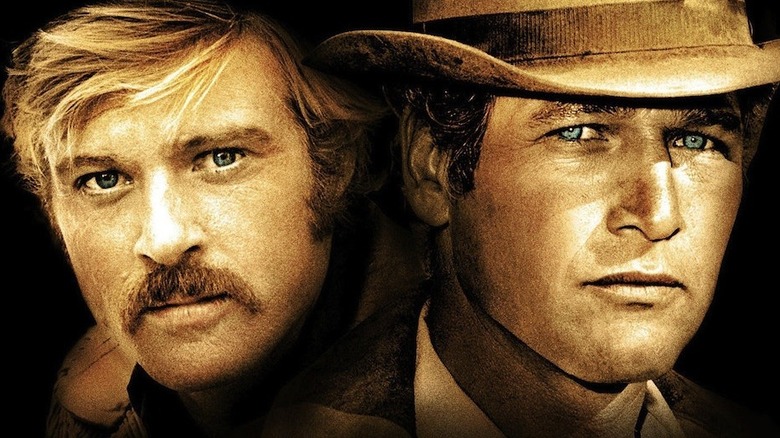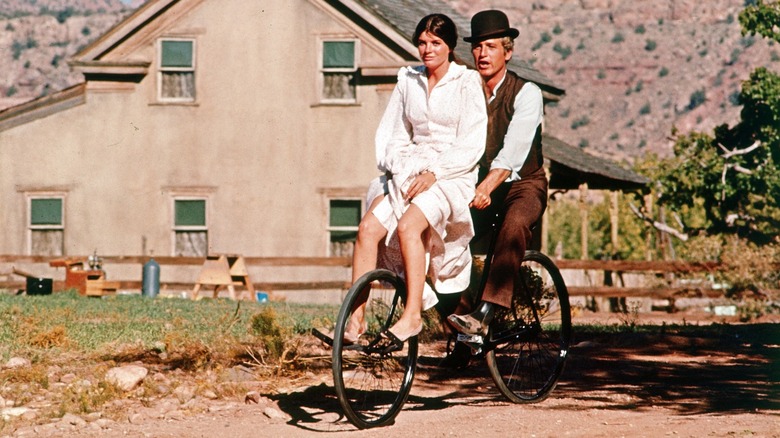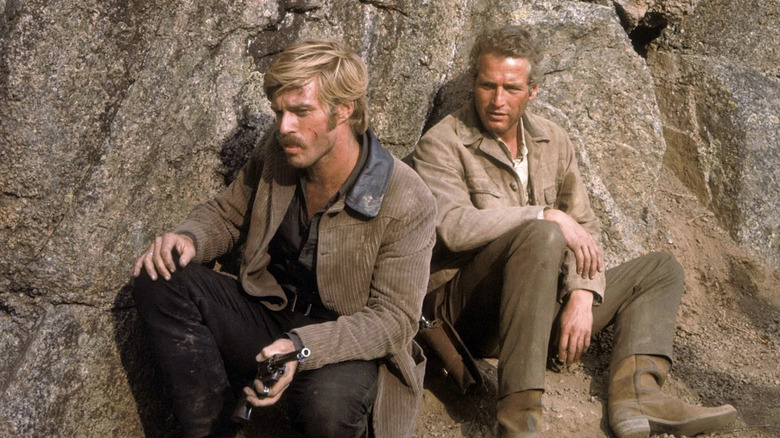The Story Of Butch Cassidy And The Sundance Kid Wasn't An Easy Fit For A Film
In silver screen Westerns, fantasy paints over reality. Real-life figures of that era, from lawmen like Wyatt Earp to outlaws like Jesse James, are as much heroes of cinema as fictional ones like the Man with No Name.
"Butch Cassidy and the Sundance Kid" is one of the most famous cases of the former. It's also an unusual Western; its focus is foremost on character and comedy, while shootouts are secondary. It has an unconventional structure, with both a half-hour long chase scene that sustains suspense all the way, mixed with leisurely, vignette-structured pacing of contemporary New Hollywood films. When the film debuted in 1969, Westerns were on their way out. Reflecting history and the genre's twilight, "Butch Cassidy and the Sundance Kid" end with the pair dying at the hands of the Bolivian army.
Screenwriter William Goldman was attracted to the story of Cassidy and Sundance because it was unusual for a cowboy, or even American, story. Interviewed for "William Goldman: The Reluctant Storyteller" by Sean Egan, Goldman recounted:
"The whole reason I wrote the ... thing, there is that famous line that Scott Fitzgerald wrote, who was one of my heroes, 'There are no second acts in American lives.' When I read about Cassidy and Longabaugh and the superposse coming after them—that's phenomenal material. They ran to South America and lived there for eight years and that was what thrilled me: they had a second act. They were more legendary in South America than they had been in the old West ... It's a great story."
The very things that intrigued Goldman about the story hamstrung the movie on its road to being made.
Too sprawling a story
Goldman's "Adventures in the Screen Trade" details how he wrote "Butch Cassidy and the Sundance Kid" (at least one edition also includes the finished screenplay). During Goldman's exhaustive research, he found the story of Cassidy and Sundance wasn't an easily condensed one. Why? There was too much to condense. Goldman called the story "sprawling," noting how it stretched not only across years but from North to South America as well. Now, long-running Westerns weren't unheard of: "How The West Was Won," released in 1962, ran 164 minutes and spanned 50 years. However, Goldman didn't think that length was the best fit for the material:
"Now, if you're writing an epic, you can sprawl to your heart's content, but this was no epic; rather, I thought it was a personal story of these two unusual outlaws."
The final cut of the movie spanned nine years, covering the Hole-In-The-Wall Gang's train robbing exploits in 1899 Wyoming to Cassidy and Sundance's eventual demise in Bolivia during 1908. Despite this, it runs a mere 110 minutes, an appropriate length for a buddy comedy.
A few things help the movie's flow. It begins in media res; Butch and Sundance are already established outlaws and friends when the audiences meet them. Another movie (especially one made in 2022) would show more backstory, such as the pair's first meeting or how Harry Longabaugh became "the Sundance Kid." There's also several montages, such as Butch and Etta (Katharine Ross) riding a bicycle together or a collection of still photos when the three leads decide to head for Bolivia.
John Wayne don't run away
Once Goldman completed the first draft in 1966, he still had to find a studio to make the movie. As detailed in a TCM write-up of the movie's history, one executive disliked how the leads fled to Bolivia instead of challenging their pursuers to the death. Goldman's explanation that this was how history played out fell on deaf ears: the executive responded, "John Wayne don't run away."
Goldman eventually found a buyer in Richard Zanuck, then head of 20th Century Fox. Yet, the challenges didn't end. As we've written about before, finding the right leading men to play Butch and Sundance was a journey. Newman was considered from the beginning, but initially as the Sundance Kid. Attempts to pair him with Jack Lemmon or Steve McQueen as Butch Cassidy failed. Newman, who eventually settled on playing Butch himself, and director George Roy Hill pushed for the then-unknown Redford as Sundance and eventually prevailed.
"Butch Cassidy and the Sundance Kid" wasn't easy to get to film, especially since it broke convention along the way. Those departures from the norm, in the film's storytelling to its casting, are why it's still remembered.


